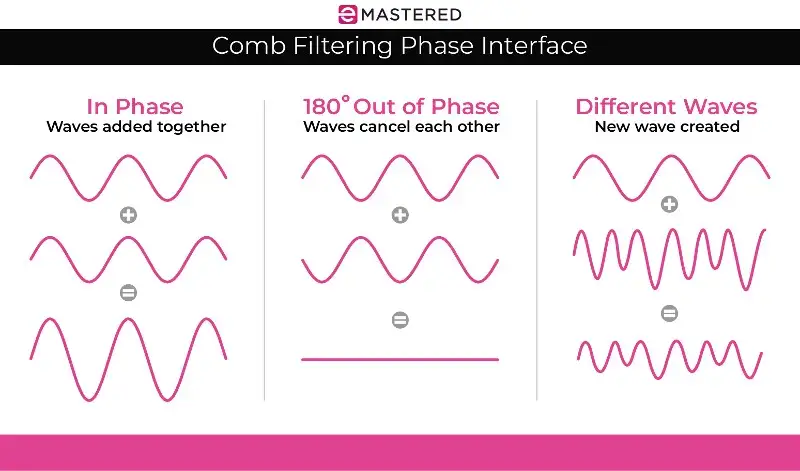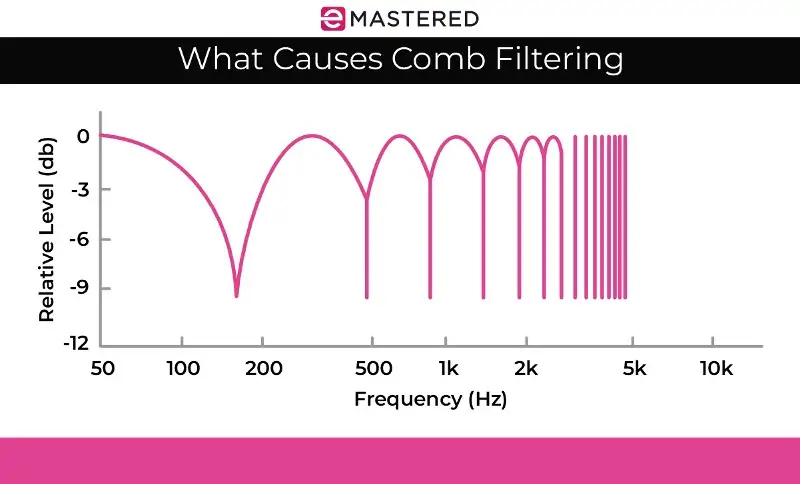Becoming a master of sound requires time, patience, and most importantly, a keen understanding of how sound waves work. If you record often, you'll probably come across the phenomenon of comb filtering, a type of phase interference.
Below, we'll explain exactly what comb filtering is and teach you how to combat it effectively. Let's take a look!
What Is Comb Filtering?
Comb filtering is caused by two identical sound waves being played out of sync, also described as phase interference. In a comb filter, some portions of the sound wave are canceled out or silenced, while other parts of the signal are amplified or made louder.
The reason why it is called comb filtering is due to the combined sound wave's comb-like appearance.
Understanding Phase Interference
To understand comb filtering, we must first take a look at phase interference. Phase interference refers to what happens when two identical signals are played slightly out of sync, sometimes just milliseconds apart.
This distance can cause sounds to cancel out, which is referred to as destructive phase interference. Two in-sync sound waves combined creates a louder sound, referred to as conductive phase interference.
Comb filtering occurs as a mix of destructive and conductive phase interference as displayed below.

Sound Waves In Phase
When sound waves are in phase, they align and create a higher amplitude or volume. In-phase sound waves do not cause any phase interference.
Sound Waves Out of Phase
When sound waves are perfectly 180 degrees out of phase, they cancel each other out effectively making the initial sound silent. Whenever portions of out-of-phase audio cancel each other out, this is called destructive phase interference. This phase interference can occur at different rates, but only at 180 degrees do two sounds completely cancel each other out.
What Causes Comb Filtering?
Comb filtering is a specific type of destructive interference in which the sound waves form a comb-like combined wave. A comb filter consists of high and low peaks which showcases the output when the same sound takes multiple routes and creates an unexpected delay in this particular shape.
Comb filtering can make for a very immersive listening experience when used stylistically, but you'll want to avoid comb filtering occurring unintentionally.

What Does Comb Filtering Sound Like?
Many describe comb filtering as having a hollow or nasal-like sound. It can also sound similar to what you would hear when using a phaser or phase shift plugin, which checks out since comb filtering is just a specific type of phase interference. The best way to understand the sound of comb filtering is to take a listen yourself:
You'll note, as shown in the above video, the closer the microphone was to the reflected sound board, the stronger the comb filtering effect was. This demonstration was with white noise, but the comb filtering effect can occur with any delayed signal sources.
How To Avoid Comb Filtering
Now we understand how comb filtering works and how to detect it in a mix. While some might deliberately manipulate sound wave placement to create comb filtering, in most cases, you'll probably want to avoid this destructive phase interference. Here are several waves you can avoid comb filtering caused by common audio setup mistakes:
Treat Reflections
Two waveforms can reach a sound source at different times if they are reflected off of surfaces. This is why it's key to invest in studio panels or sound treatments that absorb reflections in your live sound environment. You can also help yourself out by recording in a space without any echo, windows, or hollow surfaces that will reflect sounds.
Use Proper Monitor Placements
Improper monitor placement can create an inaccurate representation of your mix as a whole. It's important to build your home studio with intention and place your monitors properly so that you can effectively check for any unwanted phase interference.
Minimize Bleed
When recording, you want to focus on getting a direct sound as much as possible. Record in a sound-treated environment whenever you can, so that you don't pick up background noise sometimes dubbed as "noise bleed". Recording isolated audio makes it impossible to create unwanted comb filters since you won't have two of the same sound sources with one on a slight delay.
Use Proper Microphone Placement
Using proper microphone placement can help you cut down on potential comb filtering effects. Record far from reflective surfaces, and in most circumstances, it's advised to record in mono . This is the default in most DAWs for a reason. Note that you can still place mono tracks within a wide stereo image.
If you have to record with multiple microphones, use the 3:1 guideline. The 3:1 rule dictates that any microphones should be at least three meters apart to prevent any unwanted interference.
Rerecord When Needed
If you detect sound leakage, audio coming in a few milliseconds behind, or interference while recording the same sound source, it's best to rerecord. Your recordings are your source material. Everything builds on top of them, so if your recordings have obvious mistakes, it's near impossible to kick off your song on a good foot.
Comb Filtering FAQs
Comb filtering can be more common than you may think. Check out these commonly asked questions and answers to help you avoid this phasing issue.
What is the comb filtering effect?
When two or more similar sound waves interfere with one another, they create phase interference. Comb filtering refers to a specific type of phase interference, which looks like a comb with peaks and valleys when shown on a spectral analyzer.
What causes comb filtering?
Comb filtering occurs when a sound source is picked up by multiple microphones or when the same signal is reflected across multiple surfaces. This can create delay, which leads to the phase interference leading to the aforementioned comb filtering effect.
What does comb filtering look like?
In a spectral analyzer, comb-filtering sound waves look like the teeth of a comb, hence the namesake. This appearance is due to a series of peaks and clips created by phase interference which leads to a comb filter.
How do you treat comb filtering?
The best way to combat comb filtering is to stop it during the recording stage. You'll want to mitigate reflective surfaces by sound treating, monitoring your active frequency response, and take to to use proper microphone and monitor placement.
Can you hear comb filtering?
Comb filtering sounds are highly varied based on the source sound. You may hear swirling or phaser-like sound when your inputs are comb filtering. It's important to note that although comb filtering is generally to be avoided, it can be used in very specific contexts to add interest to the same sound.
Is comb filtering the same as phase?
Phase refers to the relationship between two sound waves with the same frequency response. Comb filtering is a type of phase interference, where the direct sound phase creates a comb-like shape.
When used deliberately, comb filtering can be a fun tool to create an interesting mix. Hopefully, this guide makes it easier for you to use these principles to avoid unwanted phase shifts and work around the phenomenon of comb filtering.





